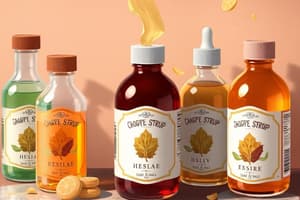Podcast
Questions and Answers
Syrups are characterized by a sweet taste and relatively high ______.
Syrups are characterized by a sweet taste and relatively high ______.
viscosity
Syrups can be classified into non-medicated and ______ syrups.
Syrups can be classified into non-medicated and ______ syrups.
medicated
Sugar-based syrups are concentrated solutions of ______.
Sugar-based syrups are concentrated solutions of ______.
sugar
Sugar-free syrups are formulated with artificial sweetening agents and viscosity ______.
Sugar-free syrups are formulated with artificial sweetening agents and viscosity ______.
Sucrose is the preferred carbohydrate for syrups due to its purity, degree of sweetness, and lack of ______.
Sucrose is the preferred carbohydrate for syrups due to its purity, degree of sweetness, and lack of ______.
One disadvantage of sucrose-based syrups is that they are subjected to fermentation and ______.
One disadvantage of sucrose-based syrups is that they are subjected to fermentation and ______.
The growth of moulds and yeasts in sucrose solutions can lead to turbidity, change in odor, and change in ______.
The growth of moulds and yeasts in sucrose solutions can lead to turbidity, change in odor, and change in ______.
Syrups should contain enough sucrose to approach ______ to prevent microbial growth.
Syrups should contain enough sucrose to approach ______ to prevent microbial growth.
Sucrose undergoes hydrolysis to give ______ and glucose.
Sucrose undergoes hydrolysis to give ______ and glucose.
This reaction is also called an 'inversion reaction' because sucrose rotates polarized light to the right while the products rotate it to the ______.
This reaction is also called an 'inversion reaction' because sucrose rotates polarized light to the right while the products rotate it to the ______.
Dextrose displays a sweetness rating of ______ percent.
Dextrose displays a sweetness rating of ______ percent.
The change in color that occurs during caramelization is associated with the formation of ______.
The change in color that occurs during caramelization is associated with the formation of ______.
Compared to sucrose, dextrose ______ more slowly.
Compared to sucrose, dextrose ______ more slowly.
Dextrose forms a saturated solution in water at ______ percent w/v.
Dextrose forms a saturated solution in water at ______ percent w/v.
Preservatives are usually required for ______-based syrups.
Preservatives are usually required for ______-based syrups.
Glycerine may be used in a concentration of ______ to act as a preservative for dextrose-based syrups.
Glycerine may be used in a concentration of ______ to act as a preservative for dextrose-based syrups.
Flashcards are hidden until you start studying
Study Notes
Syrups
- Syrups are concentrated, sweet, viscous solutions made from sugar, with or without medicinal or flavoring ingredients.
- Two classifications of syrups:
- Non-medicated syrups: Act as vehicles for other preparations.
- Medicated syrups: Contain active pharmaceutical ingredients (APIs) and have therapeutic effects (e.g., antihistamines, cough suppressants).
- Additional classifications based on sugar type:
- Sugar-based syrups: Use concentrated solutions of sugars like sucrose and dextrose.
- Sugar-free syrups: Formulated with artificial sweeteners and viscosity builders (e.g., saccharin sodium, sorbitol, sodium cyclamate) for patients with dietary restrictions.
- Sugar-free syrups require viscosity builders like glycerine, methyl cellulose (MC), and hydroxyethyl cellulose (HEC) to achieve the desired thickness.
Sucrose-Based Syrups
- Sucrose is the preferred carbohydrate for syrups due to its:
- Purity: Commercially available in pure form.
- Sweetness: Has a sweetness rating of 100%.
- Lack of color: Colorless.
- Ease of handling: Easy to work with.
- Inertness: Does not readily react with other substances.
- Availability: Readily available.
- Sucrose-based syrups are susceptible to:
- Fermentation: Microorganisms like molds and yeasts can grow in dilute solutions of sucrose, leading to changes in:
- Turbidity (cloudiness)
- Odor
- Taste
- Hydrolysis: Sucrose, a disaccharide, breaks down into fructose (levulose) and glucose (dextrose) in the presence of strong acids or heat.
- This reaction is called "inversion" because it changes the direction of light rotation from right to left.
- The inverted sugar is more susceptible to fermentation and sweeter than sucrose due to the presence of levulose.
- The formation of levulose contributes to brown discoloration (caramelization) in syrups containing strong acids.
- Fermentation: Microorganisms like molds and yeasts can grow in dilute solutions of sucrose, leading to changes in:
Dextrose-Based Syrups
- Dextrose is used as a substitute for sucrose in syrups containing strong acids to prevent caramelization and hydrolysis issues.
- Dextrose-based syrups have the following characteristics:
- Lower viscosity: Forms a less viscous saturated solution than sucrose.
- Slower dissolving: Dissolves more slowly than sucrose.
- Less sweet: Has a lower sweetness rating (74%) compared to sucrose.
- Dextrose-based syrups are more susceptible to fermentation than sucrose syrups and usually require preservatives, such as glycerine (30-45% v/v), which also improves viscosity and adds sweetness.
Studying That Suits You
Use AI to generate personalized quizzes and flashcards to suit your learning preferences.




